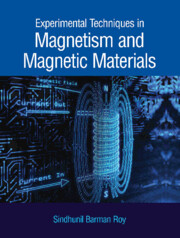Book contents
- Frontmatter
- Dedication
- Contents
- Preface
- I Introduction to Magnetism and Magnetic Materials
- II Basic Phenomenology of Magnetism
- III Experimental Techniques in Magnetism
- Appendix A Magnetic Fields and Their Generation
- Appendix B Units in Magnetism
- Appendix C Demagnetization Field and Demagnetization Factor
- Index
III - Experimental Techniques in Magnetism
Published online by Cambridge University Press: 27 October 2022
- Frontmatter
- Dedication
- Contents
- Preface
- I Introduction to Magnetism and Magnetic Materials
- II Basic Phenomenology of Magnetism
- III Experimental Techniques in Magnetism
- Appendix A Magnetic Fields and Their Generation
- Appendix B Units in Magnetism
- Appendix C Demagnetization Field and Demagnetization Factor
- Index
Summary
In this part of the book we will study various experimental techniques currently employed in the study of magnetism and magnetic materials. We shall start with a very popular experimental technique called magnetometry in Chapter 6. This technique is used to study macroscopic or bulk magntic properties of materials in research laboratories all over the world. This is a versatile technique to investigate magnetic properties over a wide range of sample environments that differ from each other in terms of temperature, pressure and applied magnetic field. Magnetometry is usually the first experiment to perform for the general magnetic characterization of materials, which apart from providing a plethora of useful information enables one to identify and focus on the particular temperaure, pressure and magnetic field regime of interest for deeper investigation using more specialized experimental techniques.
Electromagnetic (EM) radiation is an interesting probe to study magnetic properties of materials. A material containing magnetic dipoles is expected to interact with the magnetic component of EM radiation. If the material of interest is subjected to a static magnetic field, it is possible to observe a resonant absorption of energy from an EM wave tuned to an appropriate frequency. This phenomenon is known as magnetic resonance. Depending upon the type of magnetic moment involved in the resonance, a number of different experimental techniques can be employed to study magnetic resonance. In Chapter 7 we shall discuss such experimental techniques as nuclear magnetic resonance (NMR), electron paramagnetic resonance (EPR), ferromagnetic resonance (FMR), and Mössbauer spectroscopy, along with muon spin rotation (μSR).
In Chapter 8 we will study experimental techniques employing interaction of EM waves with magnetic material without any resonant absorption. Magneto-optical effects can arise due to an interaction of electromagnetic radiation with magnetic material having either spontaneous magnetization or magnetization induced by the presence of an external magnetic field. Experiments based on the magneto-optical Kerr effect (MOKE) and scanning near-field optical microscopy (SNOM) will be discussed. In addition we will discuss Brillouin light scattering (BLS) or Brillouin spectroscopy, which is based on the phenomenon of inelastic scattering of light. Brillouin spectroscopy provides insights to spin waves in ferromagnetic material without exciting them explicitly.
- Type
- Chapter
- Information
- Publisher: Cambridge University PressPrint publication year: 2023

